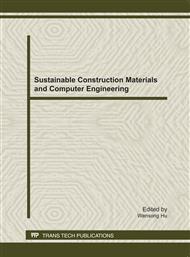[1]
G. Venter, R.T. Haftka, J.H. Starnes. Construction of response surfaces for design optimization applications. In: Proceedings of the 6th AIAA/NASA/ISSMO symposium on multidisciplinary analysis and optimization. Bellevue (Washington), September 4-6, 1996, Part 1. p.548.
DOI: 10.2514/6.1996-4040
Google Scholar
[2]
O. Balabanov. Development of approximations for HSCT wing bending material weight using response surface methodology [D]. Virginia Polytechnic Institute and State University, Blacksburg (VA); (1997).
Google Scholar
[3]
J. Sacks, S.B. Schiller, W.J. Welch. Design for computer experiment. Technometrics 1989; 31 (1): 41–7.
Google Scholar
[4]
N. A. C. Cressie, Statistics for Spatial Data, J. Wiley: New York, (1993).
Google Scholar
[5]
G. Matheron. Principles of geostatistics. Economic Geology, 1963, 58, 1246–1266.
DOI: 10.2113/gsecongeo.58.8.1246
Google Scholar
[6]
A.A. Giunta. Aircraft multidisciplinary optimization using design of experiments theory and response surface modeling methods. Ph.D. dissertation, Virginia Polytechnic Institute and State University, Blacksburg (Virginia); (1997).
Google Scholar
[7]
J.O. Osio, C.H. Amon. An engineering design methodology with multistage Bayesian surrogates and optimal sampling. Res Eng Des 1996; 8(4): 189–206.
DOI: 10.1007/bf01597226
Google Scholar
[8]
A.J. Booker, J.E. Dennis, P.D. Frank, et al. A rigorous framework for optimization of expensive functions by surrogates. Struct Optimization 1999; 17(1): 1–13.
DOI: 10.1007/bf01197708
Google Scholar
[9]
A. Sakata, F. Ashida, M. Zako. Structural optimization using kriging approximation. Comput Meth Appl Mech Eng 2003; 192(7–8): 923–39.
DOI: 10.1016/s0045-7825(02)00617-5
Google Scholar
[10]
A.A. Giunta, L.T. Watson. A comparison of approximation modeling techniques: polynomial versus interpolating models, AIAA-98-4758. 1998, 36(1): 275-286.
DOI: 10.2514/6.1998-4758
Google Scholar
[11]
T. W. Simpson, J.D. Peplinski, P.N. Koch. Metamodels for computer-based engineering design: survey and recommendations. Engineering with computers. 2000, 17(2): 129-150.
DOI: 10.1007/pl00007198
Google Scholar
[12]
P. Kyoungwoo, K. O. Park, J. L. Hyo. The application of the CFD and Kriging method to an optimization of heat sink. International Journal of Heat and Mass Transfer, 2006, 49: 3439~3447.
DOI: 10.1016/j.ijheatmasstransfer.2006.03.009
Google Scholar
[13]
K. B. Il, S. H. Dong, J. H. Geun, et al. Structural optimization for a jaw using iterative Kriging metamodels. Journal of Mechanical Science and Technology, 2008, 22: 1651~1659.
DOI: 10.1007/s12206-008-0704-2
Google Scholar
[14]
Hu Wang, Enying Li, Guang Yao Li. Parallel boundary and best neighbor searching sampling algorithm for drawbead design optimization in sheet metal forming, Struct Multidisc Optim, 2010, 41: 309–324.
DOI: 10.1007/s00158-009-0411-3
Google Scholar
[15]
J. J. M. Rijpkema, L. F. P. Etman, A. J. G. Schoofs. Use of design sensitivity information in response surface and kriging metamodels[J]. Optimization and Engineering, 2001, 2(4): 469-484.
Google Scholar
[16]
Joachim Danckert, Experimental investigation of a square-cup deep-drawing process, Journal of Materials Processing Technology, 1995(50): 375~384.
DOI: 10.1016/0924-0136(94)01399-l
Google Scholar


